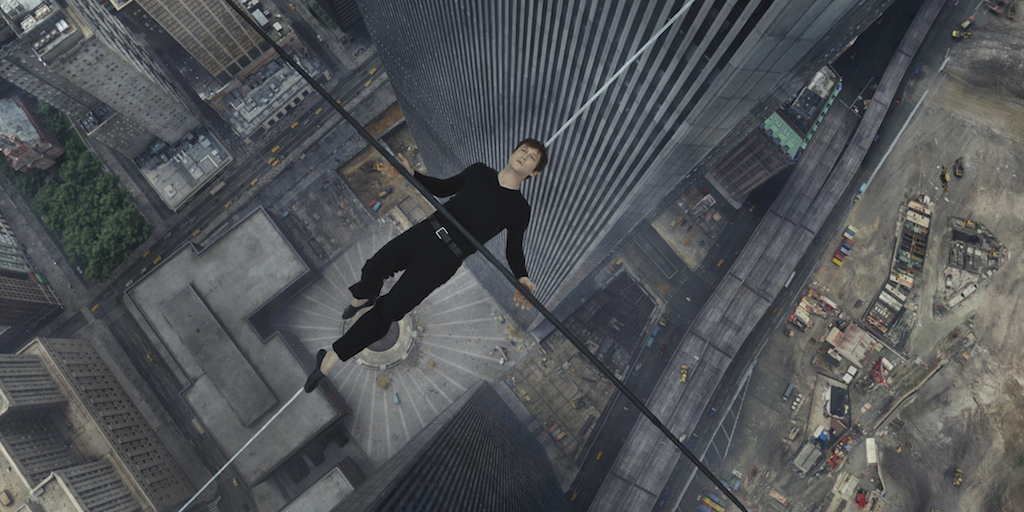
In 2008, James Marsh’s documentary Man on Wire came out, chronicling the exploits of Philippe Petit, a puckish Frenchman who was a mime, an acrobat, a wire walker, and—in his mind at least—an artist of the highest order. The film focused on his greatest stunt—a top-secret, highly orchestrated wire walk between Manhattan’s Twin Towers. The year was 1974—construction on the towers was just ending and most New Yorkers saw them as eyesores. Phillipe saw them as the most wonderful buildings on earth.
The documentary was excellent—both as a portrait of Petit, who was truly part-genius, part-maniac, and as a unique twist on the heist film (Philippe and his merry band of accomplices weren’t stealing anything, but they did have to break into the towers, hide, and even wear disguises.) Because Philippe chronicled so much of what he was doing for posterity, the documentary footage was remarkable. Nonetheless, in those pre-GoPro days, there is one thing Phillipe couldn’t show us: What it was actually like to be up on that wire. And that’s where Robert Zemeckis’s The Walk comes in.
You could make the case that Zemeckis’s film, which covers virtually the exact same material as the documentary, is unnecessary. But man oh man, once Phillipe gets on that wire the film is truly worth the price of admission. (Yes, even those exorbitant IMAX 3D prices.)
In some ways, Joseph Gordon-Levitt is the perfect choice to play Petit. He’s an old school charmer and a bit of a pied piper himself (he’s the star, head curator, and impresario of his own HitRecord indie art project). Physically, he’s wiry and graceful enough for the role. And he’s a fine actor, able to make Phillipe as infuriating as he is irresistible. The thick French accent, though, is…problematic. Suffice it to say, it’s missing that special music—the lilting dips and crescendos of a true French voice. Zemeckis doesn’t do Gordon-Levitt any favors by having him narrate the whole film, cheerfully, from a perch on top of the Statue of Liberty.
Zemeckis works hard to create a film that is as nimble and whimsical as Petit himself, and, for the most part, he succeeds. I enjoyed the early scenes of Phillipe learning how to walk a wire, being taken under the wing of a gruff and gifted highwire man named Papa Rudy (Ben Kingsley), and I enjoyed watching Phillipe acquire his crew, in classic heist fashion. But a romance with a Parisian troubadour (Charlotte Le Bon) falls flat; it feels like something being ticked off. And throw Le Bon on the pile of the film’s questionable accents: She’s a Quebecois playing a Parisian; Kingsley’s character is supposed to be Czech . . . I think.
Still, once we get up in the air all of this becomes irrelevant. For starters, just the mechanics of getting to the roof are fun—filled
with surprise allies and strokes of luck and last minute escapes (at one
point, Phillipe and a cohort are forced to dangle in an elevator shaft
for hours to evade a guard). But it’s the highwire act that will take
your breath away. When Phillipe takes that first step—no net; he was too
arrogant to ever work with a net— it manages to be awful and wonderful
at the same time. You want Phillipe off that wire as quickly as possible
and, paradoxically, you want the scene to never end. The sense of being
1,300 feet above ground is uncanny. (However, you do wish that Phillipe
would stop talking so much. For a film about a transcendent experience,
The Walk never seems to shut up.)
Ultimately, what makes The Walk extra poignant is the fact that those towers are no longer there. Zemeckis understands this and he lingers on them at the film’s end, backlit and triumphant. Phillipe’s walk changed the way New Yorkers viewed those buildings. It made them seem like part of the magic and wonder and mystery of Manhattan. In that sense, his walk truly was a work of art.
